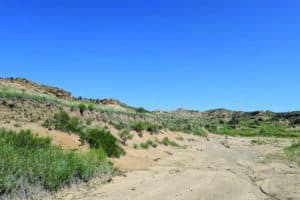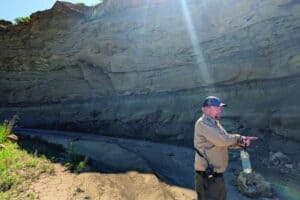Coben Scott is a history graduate, a history buff, and he has explored and researched much of Falcon and the area’s past. Coben’s column, Yesteryear, features stories about the history of the plains.
The Original Colorado Natives
Coben Scott
While today it is popular with residents born in the state to dawn a “Colorado Native” bumper sticker, the actual history of the original natives in the Falcon area goes back long before the concept of sticker claims.
The first people to cross through the prairie is actively debated and researched, but in archeologically important sites such as Jimmy Camp, Corral Bluffs and the Paint Mines, the common consensus is humans have been using this land from 5,000 to 13,000 years. Arrowheads, tools and pottery from centuries worth of people have been and are still being excavated today around the Falcon area.
Paleo-Indians, possibly ancestors of the Latin American natives traveling south, were most likely the first people to at least cross over the Falcon prairies. They would have seen untouched rolling fields of the high plains, Black Forest’s woods nearly doubled in size and Pikes Peak practically identical as it is today, but also an entirely different state of wildlife. While rattlesnakes and rabbits were still moving through the grass, so were ground sloths, mammoths and short-faced bears.
Moving a few thousand years down the line from the Paleo-Indians, the first documented people in the prairie region emerged roughly between the 1300s and 1600s — they were Apache. Unless faced with conflict, the Apache tribe was peaceful and often traded with their neighbors such as the Puebloans and Taos Indians, as they went farther south. Similar to many of the groups that inhabited the area, the Apache were plains people, often following the bison migrations and building temporary settlements.
The Kiowa people (namesake for the town and county) came to the area sometime in the late 1700s and coexisted with the Apache people. The Kiowa people came to the modern Colorado prairies and mountains from Montana, staying mostly in the Peyton Pines and Bijou Basin locations. Here, they would live in the hills and woods, then hunt on the plains before being forced south.
Arriving next (in the 1700s) is the Ute tribe, arguably the most famous in Colorado. The Utes weren’t nearly as nomadic or dependent on the plains. They were an expansionary group in the mountains, claiming territory on the western slopes and then moving eastward. The Ute, Apache and Kiowa tribes that inhabited the plains (now known as Falcon) lived among each other without conflict, but things changed when a new neighbor began setting up their teepees on the prairie.
The Comanche had already been traveling through Colorado’s great plains throughout the 1700s, but they stayed in the modern-day Spanish Peaks area during their Colorado stretch. While they set up in the Pikes Peak region, they weren’t friendly. The Comanche made lifelong enemies with the Apache, Kiowa and Ute from their early encounters. The Comanche are most likely the reason for the Apache and Kiowa tribes migrating south, choosing the Southwest desert and Spanish imperialists over the Comanche conquerors. With the Spanish occupation moving north into the Southwest, horses became available to the tribes. The Comanche mastered the horse and the other tribes did exceptionally well, too. Due to the Comanche and Ute battles with the Spanish in modern-day Southern Colorado, the Spanish were never able to create long-term settlements north of Taos, New Mexico, or Santa Fe.
One area that was conflict free in the plains was the Paint Mines. Collectively, the four tribes in their short time together agreed that the Paint Mines would only be used for clay collecting and bison hunting. The natural corrals in the Paint Mines were often used to scare bison herds into an easy hunt, and the large and colorful clay deposits were extremely important for making pottery.
Moving into the early to mid 1800s, the Apache, Kiowa and Comanche had all moved farther south. The Spanish turned their land over to Mexico, with much of their land going to the United States. The Utes had a moment of peace, holding the mountains to themselves and the occasional trapper, but that wouldn’t be for long. Two tribes came in at roughly the same time: the Cheyenne and Arapaho. They initially moved to avoid settlers in the Midwest and Great Lake regions, coming to Colorado and settling around the South Platte River on the plains.
However, another tribe, the Cherokee, moved in and caused the Cheyenne and Arapaho to move on. Native to Georgia, the Cherokee were forced onto the Trail of Tears (a forced migration of Native Americans that took place between 1830 and 1850. The United States government ethnically cleansed the Native Americans and their enslaved African Americans after a gold rush in the Appalachians was found on their land in 1839). Many did not want to be forced to live on the land provided to them, so they established the Cherokee trail; where they used the same methods they had in Georgia to find gold in waterways just south of modern-day Denver. This sparked the Pikes Peak Gold Rush of 1859, bringing in flocks of settlers and eventually forcing the Cheyenne and Arapaho to relocate in the territory.
Already by 1851, the Cheyenne and Arapaho were bound to a reservation through the Treaty of Fort Laramie, which granted the two tribes almost the entirety of the eastern plains of Colorado. By 1861, the treaty of Fort Lyon was signed, which limited their land to just north of what would be Calhan to the Arkansas River. Their reservation today would have roughly bordered Peyton.
Their land was often disrupted by settlers and the government, leading to cattle raids and looting, which prompted Gov. John Evans to require every peaceful native to temporarily relocate to an approved location. For the Cheyenne and Arapaho, the new location was a camp on the bed of Sand Creek near Fort Wise and Bent’s Fort. Tragically, this would eventually be infamously known as the Sand Creek Massacre, one of Colorado’s darkest days. In the aftermath of the massacre, surviving members of the tribes left Colorado for the Wyoming reservation. In 1875, the Cheyenne and Arapaho reservation began to shrink until it absolved sometime around 1875. The Utes, too, were forced to move to a declining reservation in 1880.
Today, remnants of the original Colorado Native Americans can be found throughout the Falcon area, through excavations in Jimmy Camp, Corral Bluffs or the Paint Mines, bent trees in Black Forest (the Utes bent trees as directional markers for locating an area of importance, like where someone died) and the woods east. There are stories from Crow’s Roost (Native American ground) near Ellicott.
The land has seen countless people come and go, but no one should forget the first native people to call these prairies home.






